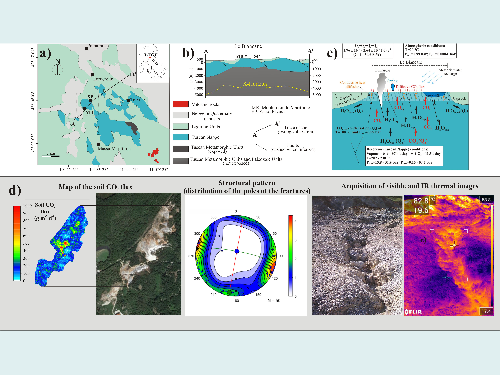Shallow portion of an active geothermal system revealed by multidisciplinary studies: the case of Le Biancane (Larderello, Italy)

Granieri D., F. Mazzarini, M. Cerminara, B. Calusi, A.
Scozzari, M. Menichini, M. Lelli (2023).
Geothermics, 108, https://doi.org/10.1016/j.geothermics.2022.102616
Summary of the study
Results have been presented for a study in the natural degassing area of Le Biancane, southern portion of the Larderello-Travale geothermal field (LTGF). LTGF is a typical vapour dominated geothermal field, classified as convective dominated plutonic type play (Moeck, 2014). It has been exploited for power production since 1913.
Compositional data of local high-T fumaroles, sampled and analyzed over the period of the investigation (May-June 2021) and previously (in 2005-2006), confirmed that H2O is the main component (98-99 % mol), followed by CO2 (0.5-1 % mol), and minor amounts of H2S, CH4 , N2 , H2 , He, Ar, CO and COS. The gases of the natural manifestations are similar in chemical composition to those discharged by local geothermal production wells, but indicate some mixing with air and air saturated water (ASW), at least for some samples.
Available data on stable isotope compositions of steam condensates (in particular those referred to hydrogen) indicate that some fumaroles (e.g., B6 and B7, located in the SW sector of Le Biancane) have compositions consistent with the isotope composition of the fluids feeding geothermal wells affected by re-injection of spent steam, while others (e.g., B8, located in the central part of Le Biancane) have similarity with the composition of geothermal wells before re-injection and therefore with the primary steam and local springs.
Gas geobarometers indicate PH2O of 15.8 bar to 31.9 bar, and PCO2 of a few tenths of bar (from 0.15 bar to 0.42 bar) in the shallow reservoir, both the intervals in agreement with those estimated for local geothermal production wells.
A total output of 11.5±0.77 t day -1 CO2 was estimated from an area of about 60,000 m 2 by using geostatistical methods. The isotopic composition of δ13C(CO2) suggests that the sedimentary formation of the Tuscan Nappe, outcropping in the Le Biancane area, is the main source of CO2 , with minor contribution of magmatic and biological CO2 . The locations with the most notable CO2 degassing (CO2 flux > 501 g m-2 day-1 ) lie in some central spots of the investigated area, near the fumarole areas, where highest soil temperature (> 50 °C) were recorded. Because the “anomalous” zones coincide with local well-connected cracks (faults and fractures), preferentially NW-SE and NE-SW trending, we believe that these cracks provide preferential but temporary pathways for fluids and heat to migrate to the surface.
Following the approach of Chiodini et al. (2001, 2005) we estimated the thermal energy loss associated with the natural degassing of Le Biancane. We calculated a thermal energy ranging from 20.4 MW to 30.6 MW taking account of the main thermal contribution of the vapour when it moves from reservoir conditions to the surface and the minor thermal contribution of the CO2 travelling with the rising vapour. These values are comparable with the nominal capacities of the individual geothermal plants currently operating in the Larderello field (most of them with nominal power of 20 MW, Razzano and Cei, 2015). This energy heats conductively the near-surface layer, producing a spatial distribution of the surface temperatures that are correlated with the soil CO2 flux in the hottest central sector of Le Biancane.


Devi effettuare l'accesso per postare un commento.